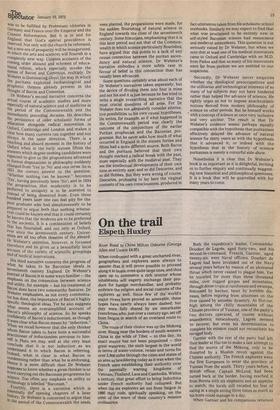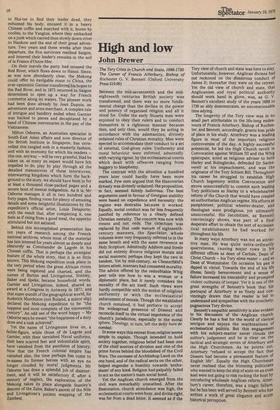On the trail
Elspeth Huxley
River Road to China Milton Osborne (George Allen and Unwin £4.95)
When confronted with a great uncharted river, geographers and explorers seem always to assume that it will prove possible to proceed along it in boats, even quite large ones, and thus open up to commerce a rich interior whose inhabitants will eagerly exchange their produce for foreign merchandise, and probably embrace the religion and social customs of the explorers as well. Since few of the world's major rivers have proved so amenable, these hopes have nearly always been dashed; but they were fully shared by six remarkable Frenchmen who, just over a century ago, set off from Saigon in search of an overland route to China.
The route of their choice was up the Mekong river. Rising near the borders of south-western China in the wilds of Tibet — to this day, its exact source has not been pinpointed — this great waterway, the sixth largest in the world in terms of water-volume, twists and turns for over 2,800 miles through the cities and states of an area as bewildering today as it was when the French were establishing their authority over the perenially warring kingdoms of Vietnam, Thailand, Laos and Cambodia. Within a century, that great effort to bring Indochina under French authority had collapsed. But when the six explorers set out from Saigon in 1866 they rode, spiritually speaking, on the crest of the wave of their country's mission civilisatrice. Both the expedition's leader, Commarfder Doudart de Lagree, aged forty-two, and his second-in-command, Francis Gamier, aged twenty-six, were Naval officers. Doudart de Lagree had been invalided out of the Navy several years before by reason of an ulcerated throat which never ceased to plague him. Yet he travelled for more than three thousand miles, over rugged gorges and mountains, through dense tropical rainforests and swamps, festooned by leeches, beset by horrible diseases, before expiring from abscesses on the liver caused by amoebic dysentry. At Hui-tse, high among the chilly mountains of the Chinese province of Yunnan, one of the party's two doctors operated, of course without anaesthetics; miraculously, Lagr6e seemed to recover; but even his determination to complete his mission could not recuscitate his ravaged body.
Gamier with the rest of the party had left their leader at Hui-tse to make a last attempt to find the source of the Mekong, only to be thwarted by a Muslim revolt against the Chinese authority. The French explorers were the first Europeans to enter the province of Yunnan from the south. Thirty years before, a British officer, Captain McLeod, had been turned back at the border, having reached it from Burma with six elephants and an appetite to match; the locals still recalled his feat of eating at a single sitting three times as much as his hosts could manage in a day.
When Gamier and his companions returned to Hui-tse to find their leader dead, they exhumed his body, encased it in a heavy Chinese coffin and marched with it, borne by coolies, to the Yangtze, where they embarked on a junk which carried then slowly down-river to Hankow and the end of their great adventure. Two years and three weeks after their departure, the five survivors reached Saigon, and interred their leader's remains in the soil of la France d'Outre-Mer.
On their travels the party had crossed the Red River, which flows down to Hanoi. Since, as was now abundantly clear, the Mekong could offer no navigable route to China, the ever-optimistic Gamier transferred his hopes to the Red River, and in 1873 returned to Saigon determined to open up a way for French commerce along its waters. The pioneer work had been done already by Jean Dupuis, an adventurer and arms merchant. A complex tale of intrigue and banditry ended when Gamier was hacked to pieces and decapitated by a band of Chinese mercenaries in the pay of the Vietnamese.
Milton Osborne, an Australian specialist in South-East Asian affairs and now director of the British Institute in Singapore, has unravelled this tangled web in a masterly fashion, and with an economy for which his readers — this one, anyway — will be very grateful. Had he taken us, as many an expert would have felt impelled to do, play by play through all the detailed manoeuvres of these interwoven, interwarring kingdoms which form the background to the story, we should have been in for at least a thousand close-packed pages and a severe bout of mental indigestion. As it is, Mr Osborne manages it all in two hundred and forty pages, finding room for plenty of amusing details and some delightful illustrations by the expedition's official artist, Louis Delaporte; with the result that, after completing it, one feels as if rising from a good meal, the appetite stimulated but not satiated.
Behind this accomplished presentation lies ten years of research among the French national archives, where most of the material has lain interred for years almost as deeply and obscurely as Commander de Lagree in his Chinese coffin. That is perhaps the strangest feature of the whole story, that it is so little known. This Mekong expedition took place in the very period when the great African rivers were being explored and charted, and the names of Burton and Livingstone, Stanley, Baker and Speke, became household words. Gamier and Livingstone, indeed, shared an award at a Congress in Antwerp in 1871; and that super-pundit of the geographical world, Sir Roderick Murchison (not Roland, a minor slip) declared the Mekong expedition to be "the happiest and most complete of the nineteenth century". An odd use of the word happy — Mr' Osborne says he meant "the happiness of a duty done and a task achieved".
Yet the name of Livingstone lives on, a father-figure, while those of de Lagree and Gamier, with their tarnished Naval uniforms, their bare scarred feet and indomitable spirit, have vanished from the pantheon of history. Now that the French colonial empire has vanished also, the time perhaps has come to re-assess its former heroes with an eye no longer clouded by moral judgments. Mr Osborne has done a splendid job of disinterment, and it will be satisfactory if, after a century of neglect, the exploration of the Mekong takes its place alongside Stanley's.
descent of the Zaire, Baker's ascent of the Nile and Livingstone's patient mapping of the Zambesi.



























 Previous page
Previous page